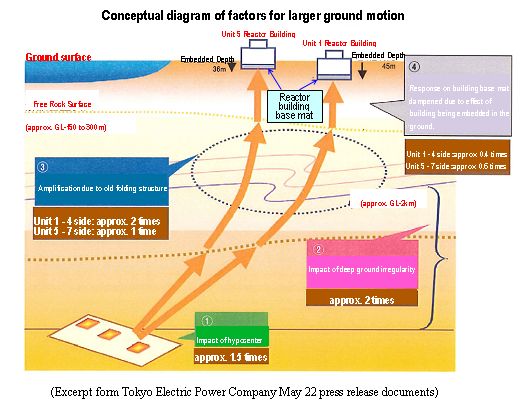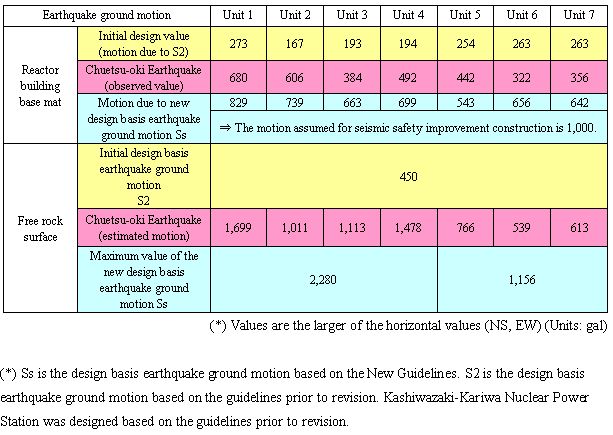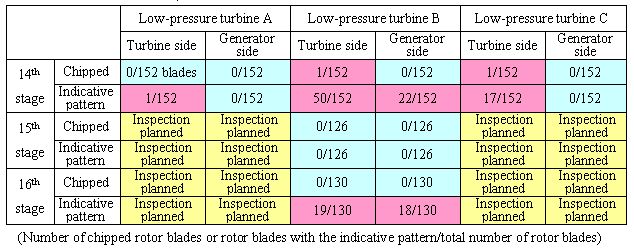|
|
 |
Post-quake status of the Kashiwazaki-Kariwa Nuclear Power Station (Report #16)
-
Progress Report on the Overall Situation up to June 12 -
In September 2006, the Nuclear and Industrial Safety Agency requested to all utilities and related organizations that they conduct seismic safety evaluations according to the revised “Guidelines for Seismic Design Evaluation of Nuclear Power Reactor Facilities” (hereinafter, “New Guidelines”), accordingly, each company has been conducting such seismic safety evaluations. Furthermore, the Minister of Economy, Trade and Industry instructed that the knowledge gained from the Niigata Chuetsu-oki Earthquake, which occurred in July 2007, be reflected in the seismic safety evaluations adequately and to expedite the completion of such.
In the previous Report #15, given such background, the “Design Basis Earthquake Ground Motion Ss establishment,” which was completed by each utility by end March of this year and was reported to NISA (excluding Kashiwazaki-Kariwa Nuclear Power Station) and the results of “Seismic Safety Evaluations” (interim report) were introduced. Now, the establishment of design basis earthquake ground motion for Kashiwazaki-Kariwa Nuclear Power Station have also been completed and reported to NISA. The outline will be introduced below. In addition, the status of turbine inspections will also be explained.
|
|
| 1. |
Establishing the design basis earthquake ground motion |
| (1) |
Status of establishment and response policy of Tokyo Electric Power Company |
| |
Taking into account the interim report results on the geological survey conducted in the vicinity of the Kashiwazaki-Kariwa Nuclear Power Station site, which was submitted to NISA on May 12, and the analysis results of the earthquake observation data acquired at the time of the Chuetsu-oki Earthquake, Tokyo Electric Power Company established the design basis earthquake ground motion Ss and submitted their report to NISA on May 22. The following is the outline. |
| a. |
Earthquake observation data analysis results
|
| |
As a result of analyzing the geological survey conducted after the Chuetsu-oki Earthquake, the earthquake data of the Chuetsu-oki Earthquake itself, and past earthquake data, it was concluded that the following factors strengthen earthquake ground motions in this area:
|
| |
| Factor 1: |
It was an earthquake that generated larger ground motions (about 1.5 times larger) compared to earthquakes of the same scale |
| Factor 2: |
The earthquake ground motion was amplified (approx. 2 times) due to the effects of the thickness and slope of the sedimentary layer of the surrounding ground |
| Factor 3: |
On the station site, there was a difference in the amplification of the ground motion between the Unit 1 to 4 side and the Unit 5 to 7 side due to the effects by the old underground fold structure underneath the station site. Earthquake ground motion for the Unit 1 to 4 side were about twice as large compared to the Unit 5 to 7 side. |
|
| |
On the other hand, from the free rock surface to the reactor building, the earthquake ground motion weakens for reasons such as the reactor building being embedded in the ground (Factor 4: approx. 0.4 times for Unit 1 to 4, approx. 0.6 times for Units 5 to 7).
|
| |

|
| |
|
| b. |
Establishment of design basis earthquake ground motion |
| |
Considering the knowledge of the amplification of the earthquake ground motion obtained from the analysis of the earthquake observation data as shown in a. above, Tokyo Electric Power Company established the design basis ground motion on the free rock surface caused by an earthquake based on the “F-B fault” and the “Nagaoka plain western edge fault belt.” This fault and fault belt are considered to significantly impact the station site. Based on this, damping that occurs when the earthquake ground motion moves from the free rock surface to the reactor building was taken into account to assess the reactor building base mat ground motion which affects major safety-related components. The following are the assessment results. |
 |
| |
|
| c. |
Seismic safety improvement construction
|
| |
In order to aim for improved seismic safety of facilities, they will implement construction to allow facilities to withstand 1,000 gal motions on the reactor building base mat for all Units 1 through 7 in the future.
|
|
|
| |
Tokyo Electric Power Company will continue to confirm the seismic safety of Kashiwazaki-Kariwa Nuclear Power Station, considering the deliberations related to the design basis earthquake ground motion established at this time made by NISA’s councils and other bodies. It will also incorporate the deliberations for the construction work to improve seismic safety. |
|
| (2) |
Response policy of NISA and the Nuclear Safety Commission
|
| |
Based on the report, NISA stated that it will make a careful assessment considering JNES analysis results and expert opinions, and reported the issue to the Nuclear Safety Commission that convened on the same day.
Given the report by NISA, the Nuclear Safety Commission has decided to carefully verify the validity of the established design basis earthquake ground motion at the Investigatory Advisory Board on Assessment of Seismic Safety and to engage in further improvement of seismic safety based on the results.
|
|
| 2. |
Inspection of the low-pressure turbine
|
| (1) |
Unit 7 |
| |
Four rotor blades (four rotor blades are affixed as an integral unit) on the 14th stage of Unit 7 low-pressure turbine C (turbine side) were removed and inspected. On March 3, the fork (blade base) of one of the rotor blades was found partially chipped. As a result of fracture surface observation, beach marks (striped pattern), which are characteristic indications of metal fatigue, were found on the surface.
The following are subsequent inspection results of similar structures (external visual inspection and non-destructive examinations).
|
| |
|
|
| (2) |
Unit 6
|
| |
For Unit 6 also, after conducting visual inspection of the low-pressure turbine B 14th stage rotor blade forks (total of 304 blades for each 152 blades), no abnormalities such as chipping were found. However, as a result of non-destructive examinations, indicative patterns were found on 28 rotor blades on the generator side and 63 rotor blades on the turbine side.
|
 |
| |
|
|
| (3) |
Future plans |
| |
It is possible that chipping and other phenomena found on the rotor blade s up to now may have occurred before the Chuetsu-oki Earthquake. However, Tokyo Electric Power Company will continue to investigate the cause including its relation with the earthquake. It will also continue to conduct external visual inspection and non-destructive examinations of the Unit 6 low-pressure turbine A and C 14th stage rotor blade forks and the low-pressure turbine B 15th and 16th stage rotor turbine forks as well as non-destructive examination of the low-pressure turbine 14th stage rotor fork attached area. |
| |
|
|
| |
End |
|
Japan Nuclear Technology Institute
Rev.0
Jun 17, 2008 |
|
|
|







